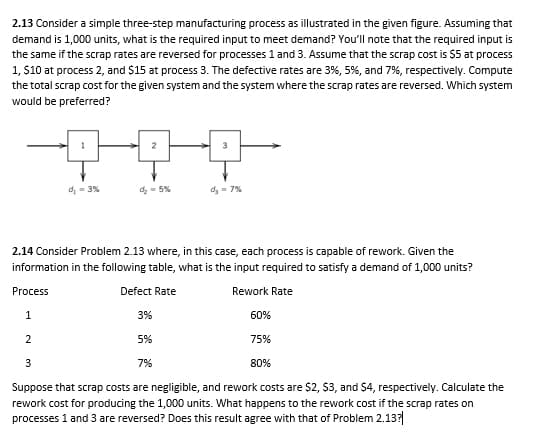2.13 Consider a simple three-step manufacturing process as illustrated in the given figure. Assuming that demand is 1,000 units, what is the required input to meet demand? You'll note that the required input is the same if the scrap rates are reversed for processes 1 and 3. Assume that the scrap cost is $5 at process 1, $10 at process 2, and $15 at process 3. The defective rates are 3%, 5%, and 7%, respectively. Compute the total scrap cost for the given system and the system where the scrap rates are reversed. Which system would be preferred? d₂-3% 7% 2.14 Consider Problem 2.13 where, in this case, each process is capable of rework. Given the information in the following table, what is the input required to satisfy a demand of 1,000 units? Process Defect Rate Rework Rate 3% 60% 5% 75% 7% 80% 1 2 3 Suppose that scrap costs are negligible, and rework costs are $2, S3, and $4, respectively. Calculate the rework cost for producing the 1,000 units. What happens to the rework cost if the scrap rates on processes 1 and 3 are reversed? Does this result agree with that of Problem 2.13?
2.13 Consider a simple three-step manufacturing process as illustrated in the given figure. Assuming that demand is 1,000 units, what is the required input to meet demand? You'll note that the required input is the same if the scrap rates are reversed for processes 1 and 3. Assume that the scrap cost is $5 at process 1, $10 at process 2, and $15 at process 3. The defective rates are 3%, 5%, and 7%, respectively. Compute the total scrap cost for the given system and the system where the scrap rates are reversed. Which system would be preferred? d₂-3% 7% 2.14 Consider Problem 2.13 where, in this case, each process is capable of rework. Given the information in the following table, what is the input required to satisfy a demand of 1,000 units? Process Defect Rate Rework Rate 3% 60% 5% 75% 7% 80% 1 2 3 Suppose that scrap costs are negligible, and rework costs are $2, S3, and $4, respectively. Calculate the rework cost for producing the 1,000 units. What happens to the rework cost if the scrap rates on processes 1 and 3 are reversed? Does this result agree with that of Problem 2.13?
Practical Management Science
6th Edition
ISBN:9781337406659
Author:WINSTON, Wayne L.
Publisher:WINSTON, Wayne L.
Chapter2: Introduction To Spreadsheet Modeling
Section: Chapter Questions
Problem 20P: Julie James is opening a lemonade stand. She believes the fixed cost per week of running the stand...
Related questions
Question

Transcribed Image Text:2.13 Consider a simple three-step manufacturing process as illustrated in the given figure. Assuming that
demand is 1,000 units, what is the required input to meet demand? You'll note that the required input is
the same if the scrap rates are reversed for processes 1 and 3. Assume that the scrap cost is $5 at process
1, $10 at process 2, and $15 at process 3. The defective rates are 3%, 5%, and 7%, respectively. Compute
the total scrap cost for the given system and the system where the scrap rates are reversed. Which system
would be preferred?
1
1
d₂ = 3%
2
d₂ = 5%
2.14 Consider Problem 2.13 where, in this case, each process is capable of rework. Given the
information in the following table, what is the input required to satisfy a demand of 1,000 units?
Process
Defect Rate
Rework Rate
3%
3
5%
d₂ = 7%
60%
75%
80%
2
3
7%
Suppose that scrap costs are negligible, and rework costs are $2, $3, and $4, respectively. Calculate the
rework cost for producing the 1,000 units. What happens to the rework cost if the scrap rates on
processes 1 and 3 are reversed? Does this result agree with that of Problem 2.13?
Expert Solution
This question has been solved!
Explore an expertly crafted, step-by-step solution for a thorough understanding of key concepts.
This is a popular solution!
Trending now
This is a popular solution!
Step by step
Solved in 2 steps with 4 images

Recommended textbooks for you

Practical Management Science
Operations Management
ISBN:
9781337406659
Author:
WINSTON, Wayne L.
Publisher:
Cengage,

Operations Management
Operations Management
ISBN:
9781259667473
Author:
William J Stevenson
Publisher:
McGraw-Hill Education

Operations and Supply Chain Management (Mcgraw-hi…
Operations Management
ISBN:
9781259666100
Author:
F. Robert Jacobs, Richard B Chase
Publisher:
McGraw-Hill Education

Practical Management Science
Operations Management
ISBN:
9781337406659
Author:
WINSTON, Wayne L.
Publisher:
Cengage,

Operations Management
Operations Management
ISBN:
9781259667473
Author:
William J Stevenson
Publisher:
McGraw-Hill Education

Operations and Supply Chain Management (Mcgraw-hi…
Operations Management
ISBN:
9781259666100
Author:
F. Robert Jacobs, Richard B Chase
Publisher:
McGraw-Hill Education


Purchasing and Supply Chain Management
Operations Management
ISBN:
9781285869681
Author:
Robert M. Monczka, Robert B. Handfield, Larry C. Giunipero, James L. Patterson
Publisher:
Cengage Learning

Production and Operations Analysis, Seventh Editi…
Operations Management
ISBN:
9781478623069
Author:
Steven Nahmias, Tava Lennon Olsen
Publisher:
Waveland Press, Inc.